Ever wondered how to harness the power of Google Search Trends to optimize your search engine optimization (SEO) strategy?
You’re not alone.
This underused tool can be a goldmine for marketers, helping them align their content with the ever-changing pulse of the Internet.
In this post, we’ll explore actionable techniques such as identifying popular topics, monitoring competitors, and using other SEO tools in tandem with Google Search Trends to boost your efforts.
Ready to ramp up your online visibility and drive traffic like never before?
Let’s dive in!

What is Google Search Trends?
Imagine having a bird’s eye view of the global hive mind, seeing what people search for on Google in real-time.
That’s precisely what Google Search Trends (or, simply, Google Trends) provides.
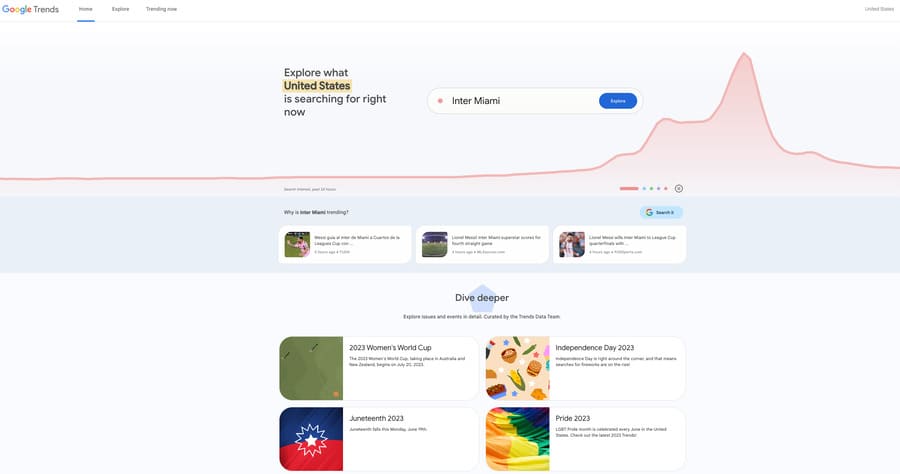
This fantastic tool offers insights based on real-time data, allowing you to measure the relative popularity of search terms rather than just their search volume.
A Google Trend includes multiple components that can revolutionize how you approach your SEO:
- Information on search queries
- Trending topics
- Categories
- Related topics
- Valuable seasonal and geographical insights
With this information at your fingertips, you can make sense of what your target audience is searching for now, as well as what they might search for next.
Use Google Search Trends to Elevate Your Content Strategy
Content creation shouldn’t be a shot in the dark. Instead, it should be a data-driven process informed by search trends.
By incorporating Google Trends data into your content marketing strategy, you can identify topics and keywords that will resonate with your audience and drive traffic to your site.
Suppose a keyword of interest is “eco-friendly.”
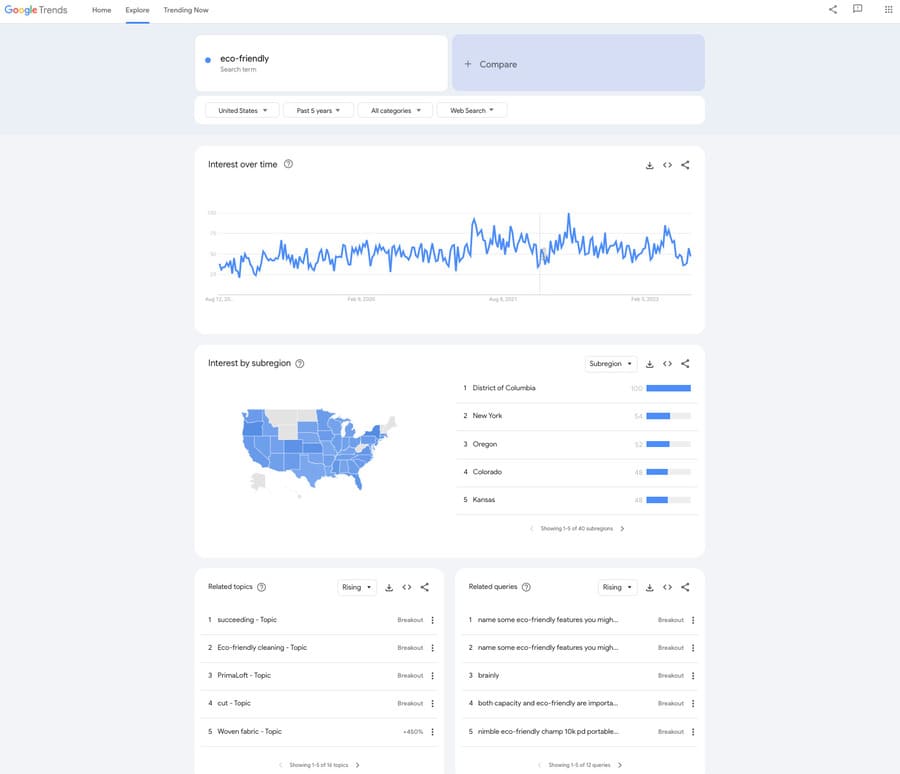
A quick search on Google Trends reveals search interest over time, regional popularity, and related topics.
By aligning your content strategy with these trends, you increase the chances of your content appearing in search results when and where interest is at its peak.
This proactive approach will help you attract more visitors to your site and build a reputation as a reliable source of up-to-date information in your niche.
The usefulness of Google Trends doesn’t stop at web searches. It can also offer insights into a trending topic on YouTube, allowing you to craft a comprehensive and well-rounded content strategy.
How Google Search Trends Can Optimize SEO
Google Trends is fabulous for determining what tips and tricks you can incorporate into your SEO strategy. Such as:
- Incorporate trending keywords in your meta tags to improve your chances of ranking high on SERPs.
- Use high-interest topics for headings and subheadings, ensuring your content is relevant to what readers are searching for.
- Structure your content based on a related topic to cover a broader spectrum of the user’s intent.
- Analyze ‘related queries’ for inspiration and include these in your content to capture a wider audience.
- Use the ‘interest over time’ feature to determine when to publish your content for maximum impact.
Tuning into the pulse of Google Trends can transform your SEO efforts from guesswork to a fine-tuned strategy.
But our exploration is far from over…
6 Ways to Leverage Google Search Trends for More Traffic
The beauty of a Google Trend lies in its versatility. Let’s explore 6 ways you can harness the power of this dynamic tool:
1. Find a Trending Topic
Staying relevant is crucial in today’s fast-paced digital world.
Use Google Trends data to discover current hot topics, produce timely content, or even brainstorm a new angle for your business.
Let’s say you’re in the fitness industry and seeking ideas for new content.
You can explore the big picture of what’s currently trending by navigating to the “Trending Now” tab (below). Here, you’ll see a myriad of potential topics:
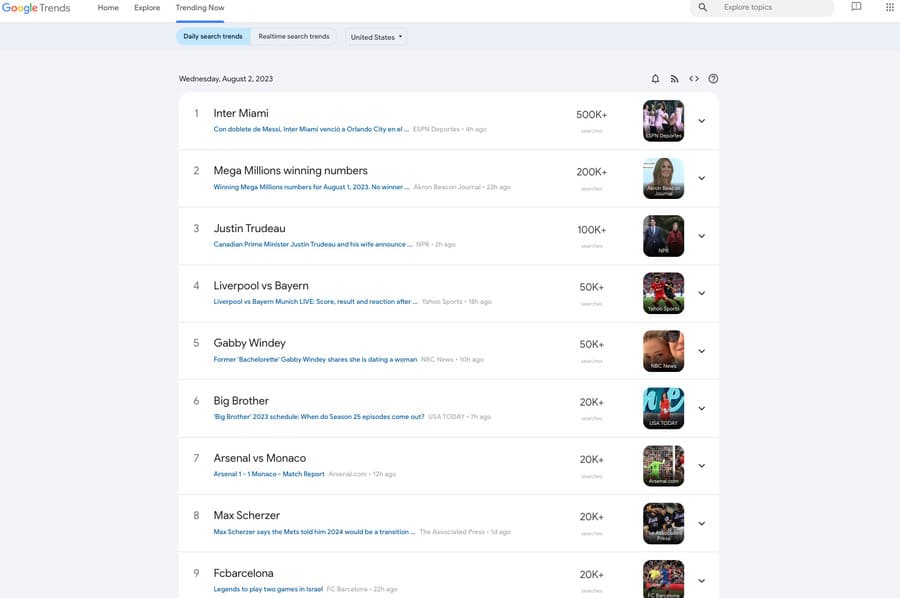
The majority of these topics or keywords may not be useful to you, but from the above example, you can see that “soccer” is relevant.
Scrolling back a few days, you’ll see a continuing trend. This is a gold nugget.
So, as a fitness expert, what could you do?
One idea is to adopt a new angle and create a workout plan integrating soccer.
Or you could create an in-depth blog post on how to improve soccer skills. You could even write a review of the latest soccer accessories.
This approach lets you capture current interest, which can drive more traffic to your site and establish you as an authority in your niche.
2. Perform Keyword Research
Keyword research is more than just discovering popular phrases; it’s about understanding the nuances of their popularity.
Use Google Trends to trace the trend of a keyword from 2004 onwards. You can even peek at the last week, day, or hour.
This feature is a game-changer, as it helps you identify keywords that are gaining traction.
Let’s consider the term “remote work” on a 5-year scale:
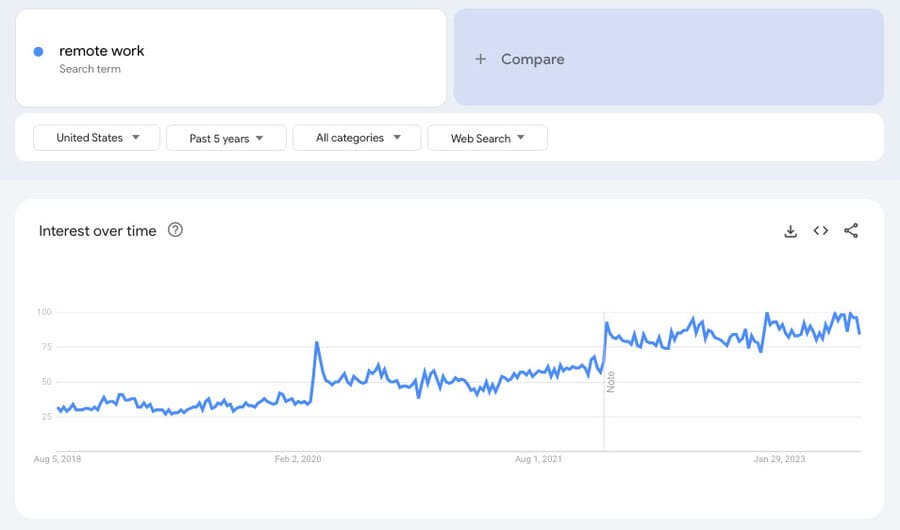
The rising graph indicates this term has slowly but steadily gained momentum.
Using a traditional SEO tool like Ahrefs alone would provide only a current snapshot, but when combined with Google Trends, you get a more complete picture.
So, by creating content around this keyword, you’re tapping into a well of growing interest.
Plus, Google Trends can help you avoid creating content around keywords on a downward trajectory.
The timeframe you choose for checking a trend is critical; using a longer timeframe helps distinguish between fads and genuine trends. It also helps identify seasonal keywords, which may otherwise appear as trending searches when viewed within a shorter timeframe.
3. Discover Related Topics
Discovering a related topic is a breeze with Google Trends. For example, let’s say you’re a finance guru interested in the target keyword “best investment books.”
An important part of your research includes discovering what topics and queries are related to this keyword so you can craft additional closely related content.
Google Trends provides information on both “top” topics and “rising” topics. Both categories of topics are useful but in different ways.
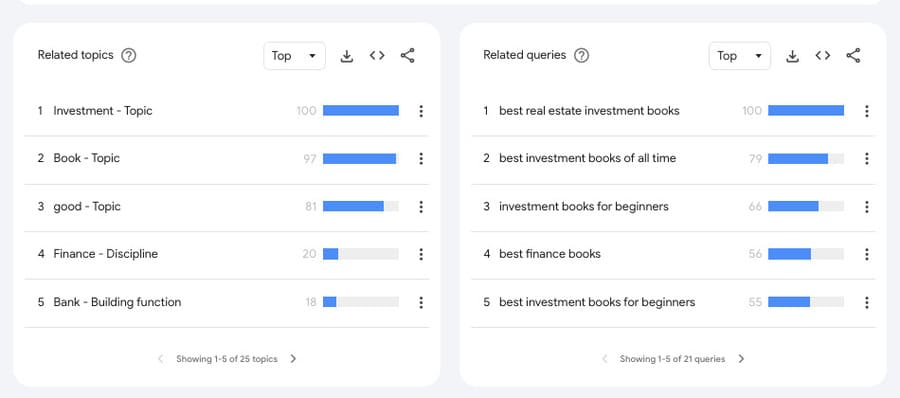
“Top topics” (shown above) are the most searched queries in a specific time frame. These are the queries with the highest search volume in a given time frame.
“Rising topics” (shown below) are those that have seen significant growth in search volume, whereas “breakout” topics are rising topics that have seen an especially large surge in interest.
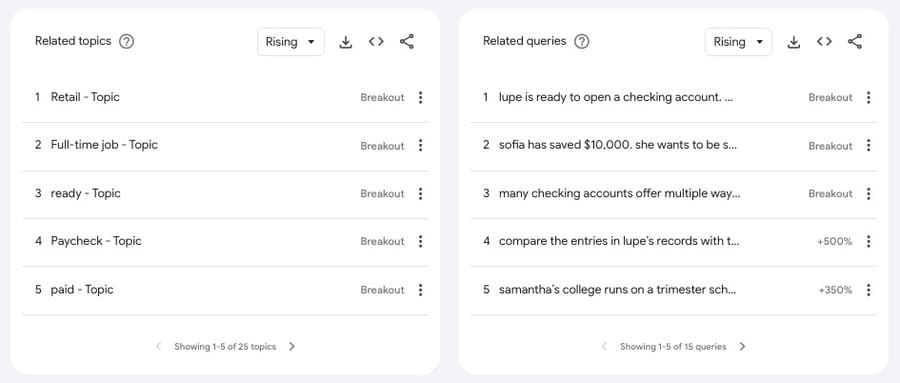
This knowledge is critical if you want to get a head start on a fast-rising search term while the keyword has low competition.
Plus, it offers an opportunity to expand your content, thus capturing a wider audience and increasing your chances of ranking higher in search results.
So, back to the example…
As a finance expert looking to expand their content, you could create a blog post around real estate investment, a Twitter thread about beginner investment tips, or even an in-depth email marketing series about retail investing.
Exploring these topics can keep your content fresh, relevant and ultimately create more value for your readers.
4. Identify Seasonal & Cyclical Trends
Understanding seasonal trends is another aspect that can drastically enhance your content strategy.
Let’s take “swimsuits” as an example:
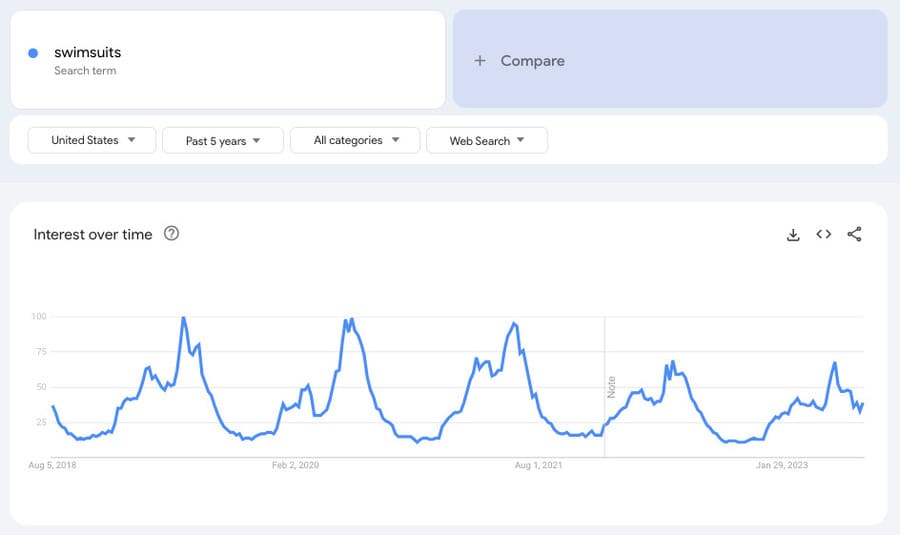
You’ll notice that this keyword peaks leading up to the summer months.
Or consider “Halloween costumes”:
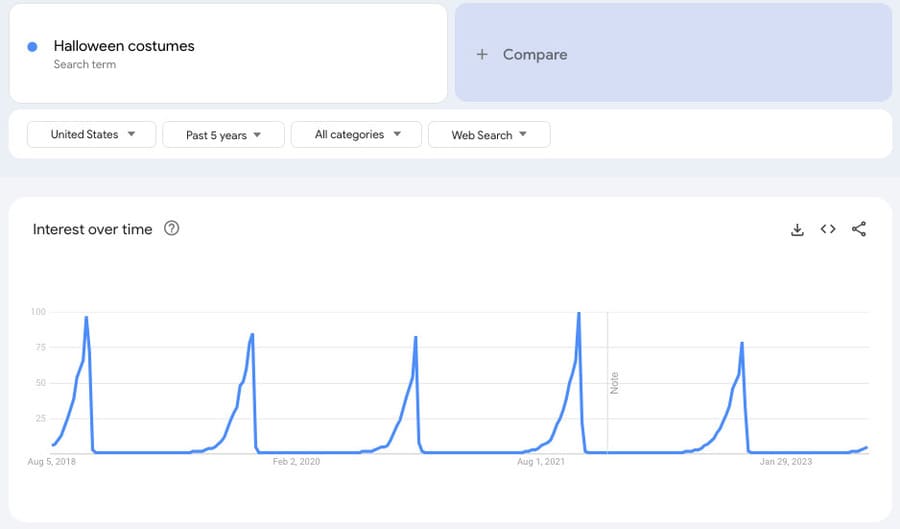
A clear peak in October.
What about “grills”?
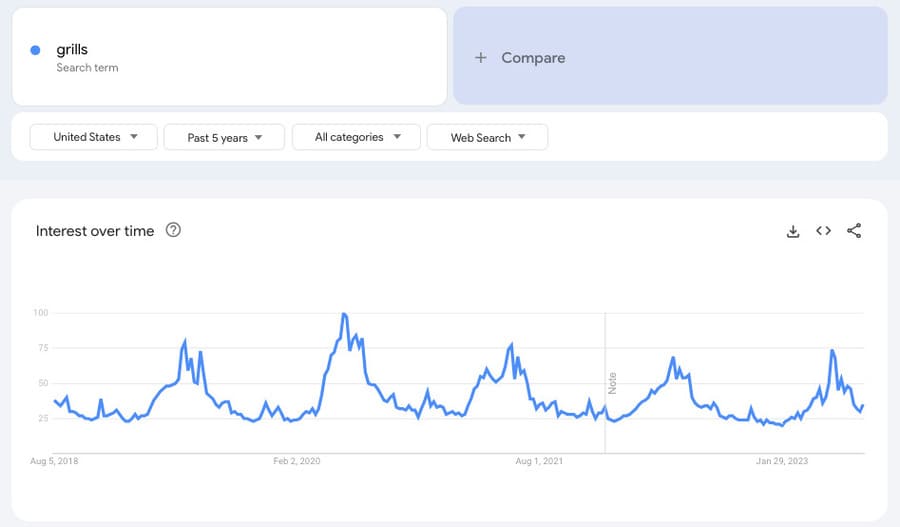
Like “swimsuits,” it’s another keyword that tops out leading toward the summer months.
But it’s not just the annual seasons that can influence searches.
Events such as the Olympics, FIFA World Cup, or even annual sales like Black Friday can create a cyclical trend in search volumes.
So, how can you use this information to elevate your traffic, engagement, and, ultimately, your digital marketing strategy?
Start by mapping your content calendar around these recurring trends. By doing so, you’re not just reacting to trends, but proactively targeting them.
Got an article from last year about “Best Black Friday Tech Deals”? Refresh it! Simply update it with the current data, and republish.
Also, think about what content can be created around the periphery of the primary trend.
The opportunities are endless.
5. Monitor Competitors & Industry Trends
Google search trends aren’t just for understanding your audience; they can also help you monitor your competitors and industry trends.
By comparing your website’s keywords with those of your competitors, you can identify content gaps and take action to stay ahead.
Suppose you operate a work-from-home blog:
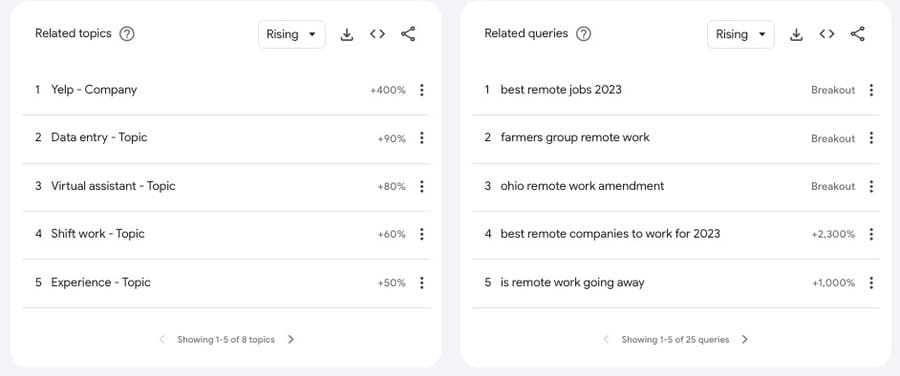
By utilizing Google Trends, you notice a surge in interest in “data entry” or “virtual assistant.”
You can compare this information with your competitor’s content, looking for gaps.
Perhaps they extensively list available remote jobs but neglect to delve into the individual roles and how to get hired.
Or maybe they miss discussing specific skills that employers desire, which are gaining popularity.
This gap in their content is your opportunity.
Using the example above, you could create comprehensive guides around “data entry” and “virtual assistants.”
By filling these gaps, you’re providing unique, in-demand content that can rank higher in search results, driving more traffic to your site and helping you outshine your competition.
6. Dominate Local SEO
Google Trends provides a wealth of data about regional or local search behavior, which can be a linchpin for businesses targeting a specific region.
It’s fascinating to see how different search trends can be, even within a short distance.
For example, in some corners of the U.S., it’s all about “soda,” and a few miles away, it’s “pop.”
And this is where the magic happens.
If you can tap into these regional nuances, you can greatly enhance your content marketing campaign.
Collaborating with local influencers can also give you an edge, and they often have their finger on the pulse of the current scene. If you have a physical store, being in sync with local festivals and events can also be a game-changer.
You could also tailor your online content to a local trend and watch it translate into actual foot traffic.
That’s the power of understanding and harnessing local SEO.
Advanced Tips for How to Use Google Search Trends

So far, we’ve covered the basics of Google Trends, but there’s more to this dynamic tool.
Here’s how you can take your knowledge and results to the next level:
Google Trends vs. Google Search Console
Many marketers often feel like they’re at a crossroads when it comes to Google Trends and Google Search Console.
Which one should you prioritize?
The magic happens when you utilize both, allowing each to complement the other in optimizing your SEO strategy.
Used in tandem, Google Trends can guide your content creation based on search interest, while Google Search Console can offer post-publishing insights on its performance.
For instance, if Google Trends suggests that a certain term in your niche is gaining traction in popularity, you could write an article about it.
Then, use Google Search Console to monitor its performance and make adjustments based on real-time data.
Combine Google Search Trends with Other SEO Tools
In the world of SEO, the more data you have, the more refined your strategy becomes. Google Trends provides a macro-level view of global or regional search interests.
Other SEO tools can delve even deeper, offering specific insights into backlinks, domain authority, and competitive analysis.
Let’s say Google Trends shows that “sustainable fashion” is a rising keyword, and you’re considering creating an article on it.
But how do you know which websites are leading in this niche?
That’s where tools like Ahrefs, SEMrush, and Moz come in.
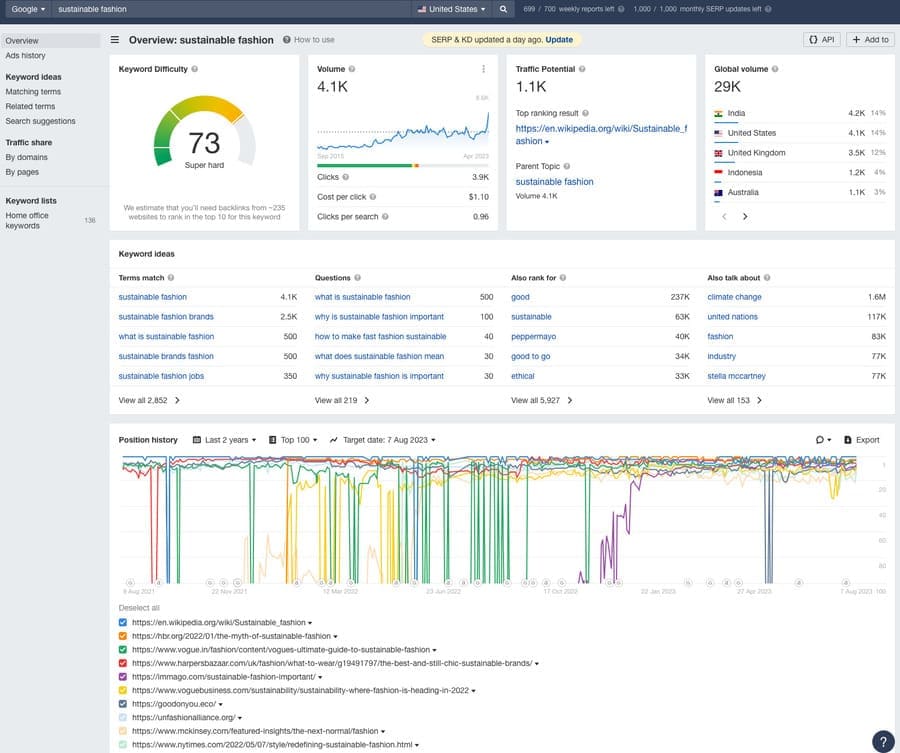
For example, in the screenshot from Ahrefs above, you can see the keyword difficulty (73), search volume for the keyword “sustainable fashion” (4.1k US), and a list of the sites currently ranking for the term.
Additionally, Ahrefs and other tools allow detailed competitive analysis to discover content gaps in your own site.
This is a great way to discover a unique angle for your next piece!
Ready to Unleash the Power of Google Search Trends?
Feeling overwhelmed by the vast SEO wilderness? You’re not alone.
Google Search Trends can be your guiding star.
But remember, insights mean little without action.
So, harness the information in this guide, refine your content, and let Google Trends help you take your content creation and SEO to the next level!



